NEF4102 Capstone: CFD Simulation of Airflow in IC Engine Manifold
VerifiedAdded on 2023/06/12
|23
|6823
|207
Project
AI Summary
This project delves into the computational fluid dynamics (CFD) simulation of airflow within an internal combustion (IC) engine manifold, utilizing ANSYS Fluent. The research focuses on simulating the movement of fluid inside the manifold and cylinder during intake, compression, power delivery, and exhaust processes, employing realistic geometries and piston movements. The analysis includes fluid movement, temperature variation, and calculations of power required and delivered. The project aims to achieve even distribution of the air-fuel mixture, optimize volumetric efficiency, and improve engine performance. It also addresses challenges such as turbulence modeling and maintaining equal pressure across the plenum, with specific attention to the restrictor, cylinder runner, and plenum components. The literature review covers various designs and methods for enhancing intake manifold efficiency, including variable geometry intake manifolds and valve timing technologies. The research contributes to a better understanding of intake manifold dynamics and offers potential improvements for engine performance.

Manifold 1
MANIFOLD
Student’s Name
Institution
Date
City
MANIFOLD
Student’s Name
Institution
Date
City
Paraphrase This Document
Need a fresh take? Get an instant paraphrase of this document with our AI Paraphraser
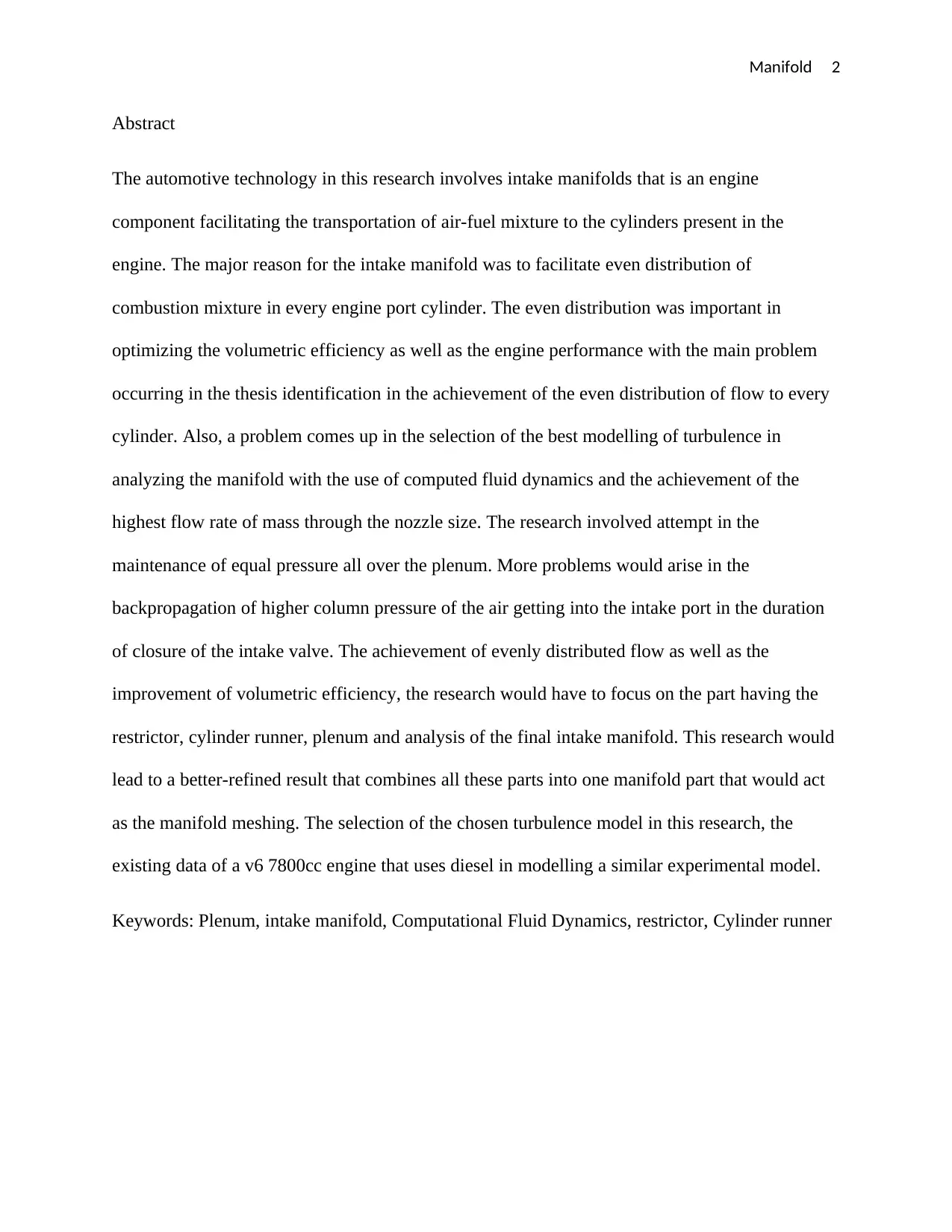
Manifold 2
Abstract
The automotive technology in this research involves intake manifolds that is an engine
component facilitating the transportation of air-fuel mixture to the cylinders present in the
engine. The major reason for the intake manifold was to facilitate even distribution of
combustion mixture in every engine port cylinder. The even distribution was important in
optimizing the volumetric efficiency as well as the engine performance with the main problem
occurring in the thesis identification in the achievement of the even distribution of flow to every
cylinder. Also, a problem comes up in the selection of the best modelling of turbulence in
analyzing the manifold with the use of computed fluid dynamics and the achievement of the
highest flow rate of mass through the nozzle size. The research involved attempt in the
maintenance of equal pressure all over the plenum. More problems would arise in the
backpropagation of higher column pressure of the air getting into the intake port in the duration
of closure of the intake valve. The achievement of evenly distributed flow as well as the
improvement of volumetric efficiency, the research would have to focus on the part having the
restrictor, cylinder runner, plenum and analysis of the final intake manifold. This research would
lead to a better-refined result that combines all these parts into one manifold part that would act
as the manifold meshing. The selection of the chosen turbulence model in this research, the
existing data of a v6 7800cc engine that uses diesel in modelling a similar experimental model.
Keywords: Plenum, intake manifold, Computational Fluid Dynamics, restrictor, Cylinder runner
Abstract
The automotive technology in this research involves intake manifolds that is an engine
component facilitating the transportation of air-fuel mixture to the cylinders present in the
engine. The major reason for the intake manifold was to facilitate even distribution of
combustion mixture in every engine port cylinder. The even distribution was important in
optimizing the volumetric efficiency as well as the engine performance with the main problem
occurring in the thesis identification in the achievement of the even distribution of flow to every
cylinder. Also, a problem comes up in the selection of the best modelling of turbulence in
analyzing the manifold with the use of computed fluid dynamics and the achievement of the
highest flow rate of mass through the nozzle size. The research involved attempt in the
maintenance of equal pressure all over the plenum. More problems would arise in the
backpropagation of higher column pressure of the air getting into the intake port in the duration
of closure of the intake valve. The achievement of evenly distributed flow as well as the
improvement of volumetric efficiency, the research would have to focus on the part having the
restrictor, cylinder runner, plenum and analysis of the final intake manifold. This research would
lead to a better-refined result that combines all these parts into one manifold part that would act
as the manifold meshing. The selection of the chosen turbulence model in this research, the
existing data of a v6 7800cc engine that uses diesel in modelling a similar experimental model.
Keywords: Plenum, intake manifold, Computational Fluid Dynamics, restrictor, Cylinder runner

Manifold 3
Introduction
The technology in the automotive comprises of the intake manifold that facilitates the transport
of air-fuel mixture to the cylinder engine. The definition of manifold had come from the
manifold English word that has a relation to the folding together of numerous outputs and inputs.
The major reason for the intake manifold was to facilitate even distribution of combustion
mixture to every intake port of the engine’s cylinder as well as the creation of air-fuel mixture.
This was done unless the engine in the study had direct injection (Reddy & Gartling, 2010). The
even distribution of mixture has its importance in the optimization of engine performance and the
volumetric efficiency. The two main desirable technologies were found to have an influence on
the volumetric efficiency as it gets increased as well as the design of the intake manifold and the
varying timing valve technology for the exhaust and intake valves. The varying timing valve
technology has its complexity and the high cost of production. Hence, it restricts the scope of
researchers thereby making every researcher in the automotive industry focus on improving the
intake manifold.
Therefore, the room for enhancing the intake manifold would be developed further. The system
involving air intake has gone through a number of reiterations as well as improvements and the
substantial increase in the years that past (Kuzmin, 2011). These past years involved the control
of shape and dimension with permission of the engine for the production of increased amounts of
power that improve the volumetric efficiency and amount of fuel consumed.
Literature Review
(Nikrityuk, 2011)produced a design with a gaseous-fuel manifold having engines with internal
combustion. The engine had its cycle being a two-stroke type that lacks inlet valves would be
Introduction
The technology in the automotive comprises of the intake manifold that facilitates the transport
of air-fuel mixture to the cylinder engine. The definition of manifold had come from the
manifold English word that has a relation to the folding together of numerous outputs and inputs.
The major reason for the intake manifold was to facilitate even distribution of combustion
mixture to every intake port of the engine’s cylinder as well as the creation of air-fuel mixture.
This was done unless the engine in the study had direct injection (Reddy & Gartling, 2010). The
even distribution of mixture has its importance in the optimization of engine performance and the
volumetric efficiency. The two main desirable technologies were found to have an influence on
the volumetric efficiency as it gets increased as well as the design of the intake manifold and the
varying timing valve technology for the exhaust and intake valves. The varying timing valve
technology has its complexity and the high cost of production. Hence, it restricts the scope of
researchers thereby making every researcher in the automotive industry focus on improving the
intake manifold.
Therefore, the room for enhancing the intake manifold would be developed further. The system
involving air intake has gone through a number of reiterations as well as improvements and the
substantial increase in the years that past (Kuzmin, 2011). These past years involved the control
of shape and dimension with permission of the engine for the production of increased amounts of
power that improve the volumetric efficiency and amount of fuel consumed.
Literature Review
(Nikrityuk, 2011)produced a design with a gaseous-fuel manifold having engines with internal
combustion. The engine had its cycle being a two-stroke type that lacks inlet valves would be
⊘ This is a preview!⊘
Do you want full access?
Subscribe today to unlock all pages.

Trusted by 1+ million students worldwide
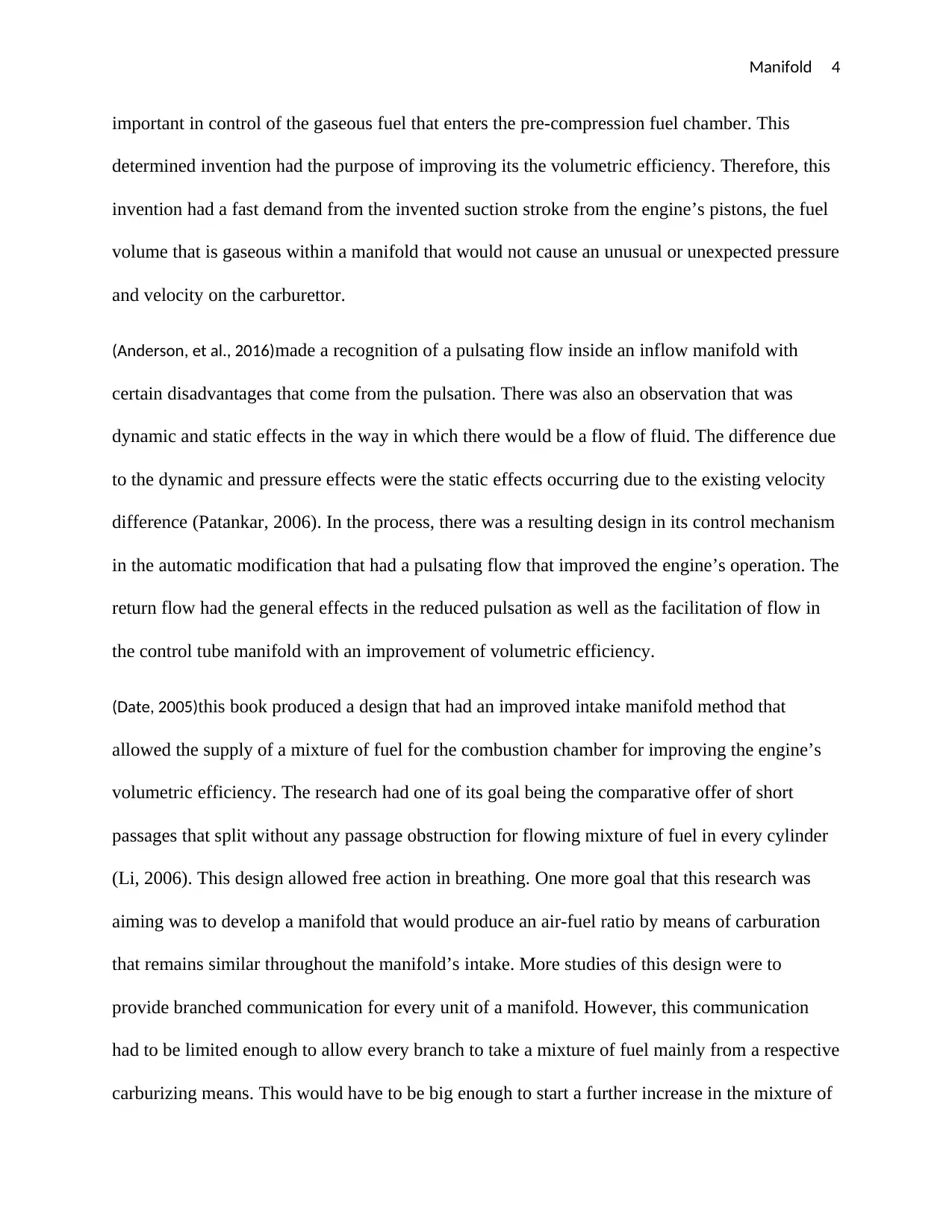
Manifold 4
important in control of the gaseous fuel that enters the pre-compression fuel chamber. This
determined invention had the purpose of improving its the volumetric efficiency. Therefore, this
invention had a fast demand from the invented suction stroke from the engine’s pistons, the fuel
volume that is gaseous within a manifold that would not cause an unusual or unexpected pressure
and velocity on the carburettor.
(Anderson, et al., 2016)made a recognition of a pulsating flow inside an inflow manifold with
certain disadvantages that come from the pulsation. There was also an observation that was
dynamic and static effects in the way in which there would be a flow of fluid. The difference due
to the dynamic and pressure effects were the static effects occurring due to the existing velocity
difference (Patankar, 2006). In the process, there was a resulting design in its control mechanism
in the automatic modification that had a pulsating flow that improved the engine’s operation. The
return flow had the general effects in the reduced pulsation as well as the facilitation of flow in
the control tube manifold with an improvement of volumetric efficiency.
(Date, 2005)this book produced a design that had an improved intake manifold method that
allowed the supply of a mixture of fuel for the combustion chamber for improving the engine’s
volumetric efficiency. The research had one of its goal being the comparative offer of short
passages that split without any passage obstruction for flowing mixture of fuel in every cylinder
(Li, 2006). This design allowed free action in breathing. One more goal that this research was
aiming was to develop a manifold that would produce an air-fuel ratio by means of carburation
that remains similar throughout the manifold’s intake. More studies of this design were to
provide branched communication for every unit of a manifold. However, this communication
had to be limited enough to allow every branch to take a mixture of fuel mainly from a respective
carburizing means. This would have to be big enough to start a further increase in the mixture of
important in control of the gaseous fuel that enters the pre-compression fuel chamber. This
determined invention had the purpose of improving its the volumetric efficiency. Therefore, this
invention had a fast demand from the invented suction stroke from the engine’s pistons, the fuel
volume that is gaseous within a manifold that would not cause an unusual or unexpected pressure
and velocity on the carburettor.
(Anderson, et al., 2016)made a recognition of a pulsating flow inside an inflow manifold with
certain disadvantages that come from the pulsation. There was also an observation that was
dynamic and static effects in the way in which there would be a flow of fluid. The difference due
to the dynamic and pressure effects were the static effects occurring due to the existing velocity
difference (Patankar, 2006). In the process, there was a resulting design in its control mechanism
in the automatic modification that had a pulsating flow that improved the engine’s operation. The
return flow had the general effects in the reduced pulsation as well as the facilitation of flow in
the control tube manifold with an improvement of volumetric efficiency.
(Date, 2005)this book produced a design that had an improved intake manifold method that
allowed the supply of a mixture of fuel for the combustion chamber for improving the engine’s
volumetric efficiency. The research had one of its goal being the comparative offer of short
passages that split without any passage obstruction for flowing mixture of fuel in every cylinder
(Li, 2006). This design allowed free action in breathing. One more goal that this research was
aiming was to develop a manifold that would produce an air-fuel ratio by means of carburation
that remains similar throughout the manifold’s intake. More studies of this design were to
provide branched communication for every unit of a manifold. However, this communication
had to be limited enough to allow every branch to take a mixture of fuel mainly from a respective
carburizing means. This would have to be big enough to start a further increase in the mixture of
Paraphrase This Document
Need a fresh take? Get an instant paraphrase of this document with our AI Paraphraser

Manifold 5
fuel that is in a branch. One more branch from a similar section would restrict mixture’s
backflow through a carburettor.
(Petrila & Trif, 2006) this research had its design being an inimitable manifold intake type for the
internal combustion engine. The main goal of this research was to come up with an intake
manifold for the production of maximum efficiency of operation in internal combustion engines.
One more objective of the research was to develop an intake manifold with an indicating
character that would enable the internal combustion engines to be equipped (Thévenin & Janiga,
2008). This would allow complete cylinder filling with the mixture of fuel in the process of the
intake stroke. Another objective of this research was to allow the provision of the intake
manifold of the indicated character that is above for an adapted prevention of pumping losses.
Such an occurrence would be possible as the manifold would reduce the atmospheric pressure
restriction to very small values (Johnson, 2016). Such a mixture of fuel would improve the
performance of the engine by the maintenance of low temperatures of the mixture that would
leave the manifold. Also, there would be a dependence on the temperature of the engine from the
intake stroke to the point where the compression stroke ends for the aiding of completing the fuel
evaporation.
(Otte, 2011)produced a design with improved intake manifold having an enhanced volumetric and
charging efficiency of the designed engine in its large range in engine load and speed. There was
a discovery of the engine’s intake efficiency as well as the combustion of the engine. The
generated swirls were the auxiliary passage intake that increased (Tucker, 2016). This increase
was possible when the major inlet passage was put in offset relationship respective to the axis
associated with the cylinder. Combining the auxiliary inlet use produced an advantageous
encounter that provided an air volume distribution that delivered an auxiliary passage intake. The
fuel that is in a branch. One more branch from a similar section would restrict mixture’s
backflow through a carburettor.
(Petrila & Trif, 2006) this research had its design being an inimitable manifold intake type for the
internal combustion engine. The main goal of this research was to come up with an intake
manifold for the production of maximum efficiency of operation in internal combustion engines.
One more objective of the research was to develop an intake manifold with an indicating
character that would enable the internal combustion engines to be equipped (Thévenin & Janiga,
2008). This would allow complete cylinder filling with the mixture of fuel in the process of the
intake stroke. Another objective of this research was to allow the provision of the intake
manifold of the indicated character that is above for an adapted prevention of pumping losses.
Such an occurrence would be possible as the manifold would reduce the atmospheric pressure
restriction to very small values (Johnson, 2016). Such a mixture of fuel would improve the
performance of the engine by the maintenance of low temperatures of the mixture that would
leave the manifold. Also, there would be a dependence on the temperature of the engine from the
intake stroke to the point where the compression stroke ends for the aiding of completing the fuel
evaporation.
(Otte, 2011)produced a design with improved intake manifold having an enhanced volumetric and
charging efficiency of the designed engine in its large range in engine load and speed. There was
a discovery of the engine’s intake efficiency as well as the combustion of the engine. The
generated swirls were the auxiliary passage intake that increased (Tucker, 2016). This increase
was possible when the major inlet passage was put in offset relationship respective to the axis
associated with the cylinder. Combining the auxiliary inlet use produced an advantageous
encounter that provided an air volume distribution that delivered an auxiliary passage intake. The

Manifold 6
use of such plenum or volume chamber produced a flow in the intake charge going into the
intake passage was possible to be stabilized regardless of the speed and eliminated pulsation or
reduced substantiality. There was a repeated research that revealed an improved intake manifold
than the previous development. Hence, the research could be summarized in that the newly
developed manifold was higher compared to the previously done research.
(Kajishima & Taira, 2016)produced a research of two ways that could be influential in increasing
the volumetric efficiency. The research provided two solutions that had variable geometry intake
manifold and a variable technology used in timing for the exhaust and intake valves. Using the
presented scenario at the time, there was a designed manifold of different types with variable
intake length in the internal combustion engine. This would lead to a variation in the inlet
geometry that allows the flow of air. This is because the main function of the inlet’s manifold air
in the engine of the internal combustion had to feed the required air amount to the combustion
chamber of the engine. The maximization of the engine performance which is the power and
torque, the used inlet manifold had to be able to provide an air of the required quantity for the
respective size (Larry, 2005). Subsequently, there would be a great volumetric efficiency in air
intake occurring at less speed of the engine (Groth & Zingg, 2006). Hence a proper engine torque
delivery at the lesser speed of the engine for improved stop-running conditions.
(Anderson, et al., 2016)made a discovery of the broken normal intake manifold had three parts that
were separate, supplement portion, runner cylinder and plenum. The fixed runner dimension was
possible to be tuned optimally for a specific speed of the engine. To get over this, a regularly
adjustable manifold runner length for the internal combustion engine. An incorporation of the
purpose of the supplement flange, plenum as well as the continuously adjustable runner length
into the plastic box that was designed from specific shaped sections (Blazek, 2005). The
use of such plenum or volume chamber produced a flow in the intake charge going into the
intake passage was possible to be stabilized regardless of the speed and eliminated pulsation or
reduced substantiality. There was a repeated research that revealed an improved intake manifold
than the previous development. Hence, the research could be summarized in that the newly
developed manifold was higher compared to the previously done research.
(Kajishima & Taira, 2016)produced a research of two ways that could be influential in increasing
the volumetric efficiency. The research provided two solutions that had variable geometry intake
manifold and a variable technology used in timing for the exhaust and intake valves. Using the
presented scenario at the time, there was a designed manifold of different types with variable
intake length in the internal combustion engine. This would lead to a variation in the inlet
geometry that allows the flow of air. This is because the main function of the inlet’s manifold air
in the engine of the internal combustion had to feed the required air amount to the combustion
chamber of the engine. The maximization of the engine performance which is the power and
torque, the used inlet manifold had to be able to provide an air of the required quantity for the
respective size (Larry, 2005). Subsequently, there would be a great volumetric efficiency in air
intake occurring at less speed of the engine (Groth & Zingg, 2006). Hence a proper engine torque
delivery at the lesser speed of the engine for improved stop-running conditions.
(Anderson, et al., 2016)made a discovery of the broken normal intake manifold had three parts that
were separate, supplement portion, runner cylinder and plenum. The fixed runner dimension was
possible to be tuned optimally for a specific speed of the engine. To get over this, a regularly
adjustable manifold runner length for the internal combustion engine. An incorporation of the
purpose of the supplement flange, plenum as well as the continuously adjustable runner length
into the plastic box that was designed from specific shaped sections (Blazek, 2005). The
⊘ This is a preview!⊘
Do you want full access?
Subscribe today to unlock all pages.

Trusted by 1+ million students worldwide
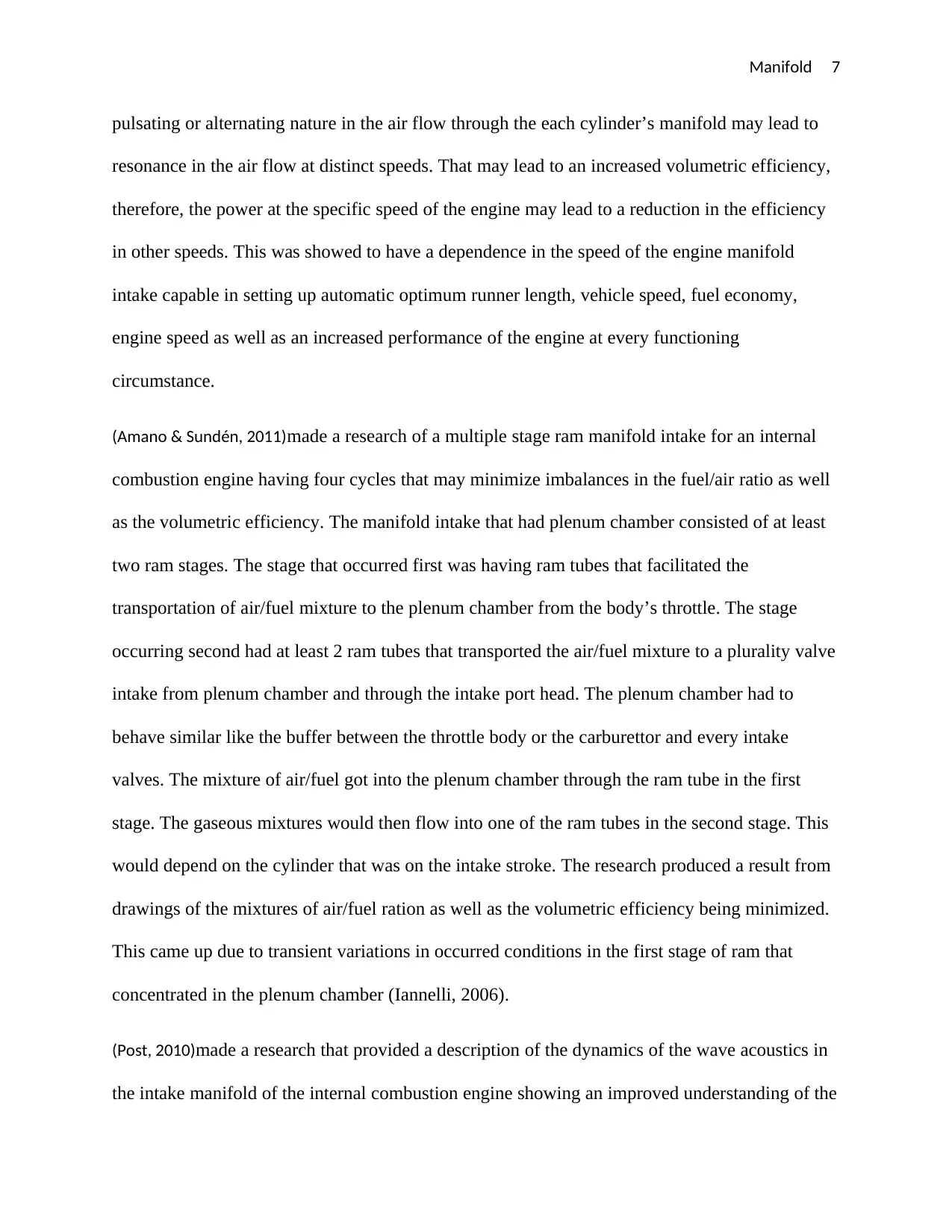
Manifold 7
pulsating or alternating nature in the air flow through the each cylinder’s manifold may lead to
resonance in the air flow at distinct speeds. That may lead to an increased volumetric efficiency,
therefore, the power at the specific speed of the engine may lead to a reduction in the efficiency
in other speeds. This was showed to have a dependence in the speed of the engine manifold
intake capable in setting up automatic optimum runner length, vehicle speed, fuel economy,
engine speed as well as an increased performance of the engine at every functioning
circumstance.
(Amano & Sundén, 2011)made a research of a multiple stage ram manifold intake for an internal
combustion engine having four cycles that may minimize imbalances in the fuel/air ratio as well
as the volumetric efficiency. The manifold intake that had plenum chamber consisted of at least
two ram stages. The stage that occurred first was having ram tubes that facilitated the
transportation of air/fuel mixture to the plenum chamber from the body’s throttle. The stage
occurring second had at least 2 ram tubes that transported the air/fuel mixture to a plurality valve
intake from plenum chamber and through the intake port head. The plenum chamber had to
behave similar like the buffer between the throttle body or the carburettor and every intake
valves. The mixture of air/fuel got into the plenum chamber through the ram tube in the first
stage. The gaseous mixtures would then flow into one of the ram tubes in the second stage. This
would depend on the cylinder that was on the intake stroke. The research produced a result from
drawings of the mixtures of air/fuel ration as well as the volumetric efficiency being minimized.
This came up due to transient variations in occurred conditions in the first stage of ram that
concentrated in the plenum chamber (Iannelli, 2006).
(Post, 2010)made a research that provided a description of the dynamics of the wave acoustics in
the intake manifold of the internal combustion engine showing an improved understanding of the
pulsating or alternating nature in the air flow through the each cylinder’s manifold may lead to
resonance in the air flow at distinct speeds. That may lead to an increased volumetric efficiency,
therefore, the power at the specific speed of the engine may lead to a reduction in the efficiency
in other speeds. This was showed to have a dependence in the speed of the engine manifold
intake capable in setting up automatic optimum runner length, vehicle speed, fuel economy,
engine speed as well as an increased performance of the engine at every functioning
circumstance.
(Amano & Sundén, 2011)made a research of a multiple stage ram manifold intake for an internal
combustion engine having four cycles that may minimize imbalances in the fuel/air ratio as well
as the volumetric efficiency. The manifold intake that had plenum chamber consisted of at least
two ram stages. The stage that occurred first was having ram tubes that facilitated the
transportation of air/fuel mixture to the plenum chamber from the body’s throttle. The stage
occurring second had at least 2 ram tubes that transported the air/fuel mixture to a plurality valve
intake from plenum chamber and through the intake port head. The plenum chamber had to
behave similar like the buffer between the throttle body or the carburettor and every intake
valves. The mixture of air/fuel got into the plenum chamber through the ram tube in the first
stage. The gaseous mixtures would then flow into one of the ram tubes in the second stage. This
would depend on the cylinder that was on the intake stroke. The research produced a result from
drawings of the mixtures of air/fuel ration as well as the volumetric efficiency being minimized.
This came up due to transient variations in occurred conditions in the first stage of ram that
concentrated in the plenum chamber (Iannelli, 2006).
(Post, 2010)made a research that provided a description of the dynamics of the wave acoustics in
the intake manifold of the internal combustion engine showing an improved understanding of the
Paraphrase This Document
Need a fresh take? Get an instant paraphrase of this document with our AI Paraphraser
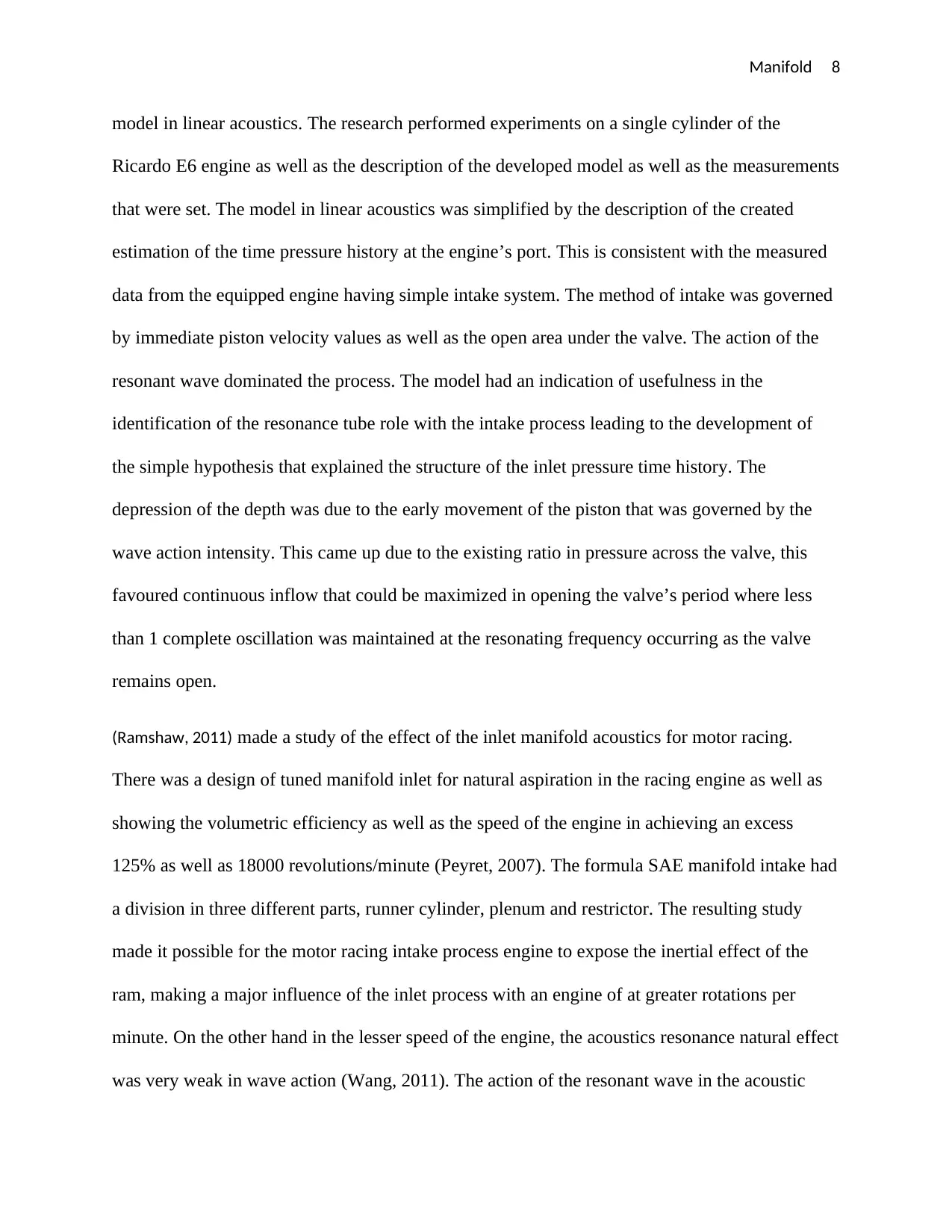
Manifold 8
model in linear acoustics. The research performed experiments on a single cylinder of the
Ricardo E6 engine as well as the description of the developed model as well as the measurements
that were set. The model in linear acoustics was simplified by the description of the created
estimation of the time pressure history at the engine’s port. This is consistent with the measured
data from the equipped engine having simple intake system. The method of intake was governed
by immediate piston velocity values as well as the open area under the valve. The action of the
resonant wave dominated the process. The model had an indication of usefulness in the
identification of the resonance tube role with the intake process leading to the development of
the simple hypothesis that explained the structure of the inlet pressure time history. The
depression of the depth was due to the early movement of the piston that was governed by the
wave action intensity. This came up due to the existing ratio in pressure across the valve, this
favoured continuous inflow that could be maximized in opening the valve’s period where less
than 1 complete oscillation was maintained at the resonating frequency occurring as the valve
remains open.
(Ramshaw, 2011) made a study of the effect of the inlet manifold acoustics for motor racing.
There was a design of tuned manifold inlet for natural aspiration in the racing engine as well as
showing the volumetric efficiency as well as the speed of the engine in achieving an excess
125% as well as 18000 revolutions/minute (Peyret, 2007). The formula SAE manifold intake had
a division in three different parts, runner cylinder, plenum and restrictor. The resulting study
made it possible for the motor racing intake process engine to expose the inertial effect of the
ram, making a major influence of the inlet process with an engine of at greater rotations per
minute. On the other hand in the lesser speed of the engine, the acoustics resonance natural effect
was very weak in wave action (Wang, 2011). The action of the resonant wave in the acoustic
model in linear acoustics. The research performed experiments on a single cylinder of the
Ricardo E6 engine as well as the description of the developed model as well as the measurements
that were set. The model in linear acoustics was simplified by the description of the created
estimation of the time pressure history at the engine’s port. This is consistent with the measured
data from the equipped engine having simple intake system. The method of intake was governed
by immediate piston velocity values as well as the open area under the valve. The action of the
resonant wave dominated the process. The model had an indication of usefulness in the
identification of the resonance tube role with the intake process leading to the development of
the simple hypothesis that explained the structure of the inlet pressure time history. The
depression of the depth was due to the early movement of the piston that was governed by the
wave action intensity. This came up due to the existing ratio in pressure across the valve, this
favoured continuous inflow that could be maximized in opening the valve’s period where less
than 1 complete oscillation was maintained at the resonating frequency occurring as the valve
remains open.
(Ramshaw, 2011) made a study of the effect of the inlet manifold acoustics for motor racing.
There was a design of tuned manifold inlet for natural aspiration in the racing engine as well as
showing the volumetric efficiency as well as the speed of the engine in achieving an excess
125% as well as 18000 revolutions/minute (Peyret, 2007). The formula SAE manifold intake had
a division in three different parts, runner cylinder, plenum and restrictor. The resulting study
made it possible for the motor racing intake process engine to expose the inertial effect of the
ram, making a major influence of the inlet process with an engine of at greater rotations per
minute. On the other hand in the lesser speed of the engine, the acoustics resonance natural effect
was very weak in wave action (Wang, 2011). The action of the resonant wave in the acoustic
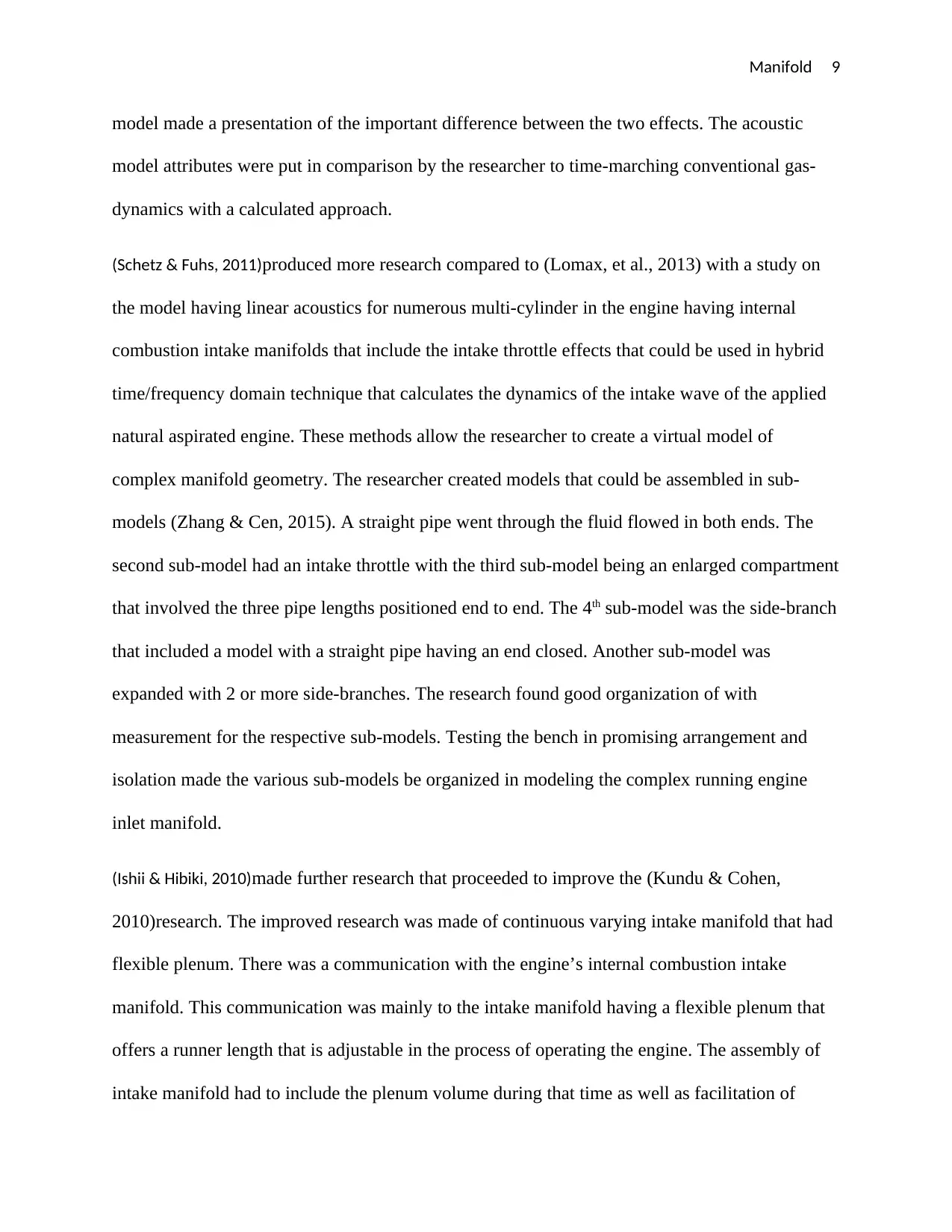
Manifold 9
model made a presentation of the important difference between the two effects. The acoustic
model attributes were put in comparison by the researcher to time-marching conventional gas-
dynamics with a calculated approach.
(Schetz & Fuhs, 2011)produced more research compared to (Lomax, et al., 2013) with a study on
the model having linear acoustics for numerous multi-cylinder in the engine having internal
combustion intake manifolds that include the intake throttle effects that could be used in hybrid
time/frequency domain technique that calculates the dynamics of the intake wave of the applied
natural aspirated engine. These methods allow the researcher to create a virtual model of
complex manifold geometry. The researcher created models that could be assembled in sub-
models (Zhang & Cen, 2015). A straight pipe went through the fluid flowed in both ends. The
second sub-model had an intake throttle with the third sub-model being an enlarged compartment
that involved the three pipe lengths positioned end to end. The 4th sub-model was the side-branch
that included a model with a straight pipe having an end closed. Another sub-model was
expanded with 2 or more side-branches. The research found good organization of with
measurement for the respective sub-models. Testing the bench in promising arrangement and
isolation made the various sub-models be organized in modeling the complex running engine
inlet manifold.
(Ishii & Hibiki, 2010)made further research that proceeded to improve the (Kundu & Cohen,
2010)research. The improved research was made of continuous varying intake manifold that had
flexible plenum. There was a communication with the engine’s internal combustion intake
manifold. This communication was mainly to the intake manifold having a flexible plenum that
offers a runner length that is adjustable in the process of operating the engine. The assembly of
intake manifold had to include the plenum volume during that time as well as facilitation of
model made a presentation of the important difference between the two effects. The acoustic
model attributes were put in comparison by the researcher to time-marching conventional gas-
dynamics with a calculated approach.
(Schetz & Fuhs, 2011)produced more research compared to (Lomax, et al., 2013) with a study on
the model having linear acoustics for numerous multi-cylinder in the engine having internal
combustion intake manifolds that include the intake throttle effects that could be used in hybrid
time/frequency domain technique that calculates the dynamics of the intake wave of the applied
natural aspirated engine. These methods allow the researcher to create a virtual model of
complex manifold geometry. The researcher created models that could be assembled in sub-
models (Zhang & Cen, 2015). A straight pipe went through the fluid flowed in both ends. The
second sub-model had an intake throttle with the third sub-model being an enlarged compartment
that involved the three pipe lengths positioned end to end. The 4th sub-model was the side-branch
that included a model with a straight pipe having an end closed. Another sub-model was
expanded with 2 or more side-branches. The research found good organization of with
measurement for the respective sub-models. Testing the bench in promising arrangement and
isolation made the various sub-models be organized in modeling the complex running engine
inlet manifold.
(Ishii & Hibiki, 2010)made further research that proceeded to improve the (Kundu & Cohen,
2010)research. The improved research was made of continuous varying intake manifold that had
flexible plenum. There was a communication with the engine’s internal combustion intake
manifold. This communication was mainly to the intake manifold having a flexible plenum that
offers a runner length that is adjustable in the process of operating the engine. The assembly of
intake manifold had to include the plenum volume during that time as well as facilitation of
⊘ This is a preview!⊘
Do you want full access?
Subscribe today to unlock all pages.

Trusted by 1+ million students worldwide
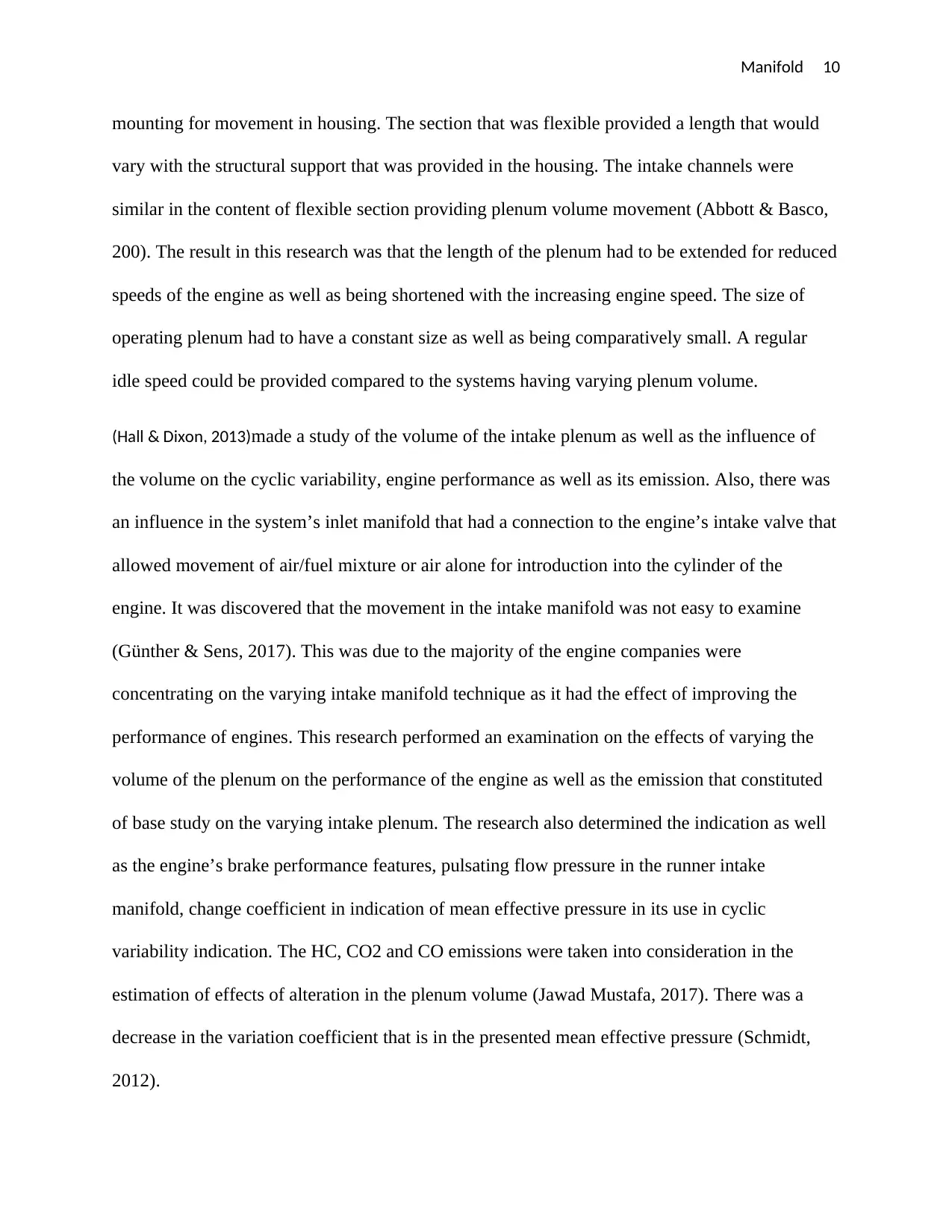
Manifold 10
mounting for movement in housing. The section that was flexible provided a length that would
vary with the structural support that was provided in the housing. The intake channels were
similar in the content of flexible section providing plenum volume movement (Abbott & Basco,
200). The result in this research was that the length of the plenum had to be extended for reduced
speeds of the engine as well as being shortened with the increasing engine speed. The size of
operating plenum had to have a constant size as well as being comparatively small. A regular
idle speed could be provided compared to the systems having varying plenum volume.
(Hall & Dixon, 2013)made a study of the volume of the intake plenum as well as the influence of
the volume on the cyclic variability, engine performance as well as its emission. Also, there was
an influence in the system’s inlet manifold that had a connection to the engine’s intake valve that
allowed movement of air/fuel mixture or air alone for introduction into the cylinder of the
engine. It was discovered that the movement in the intake manifold was not easy to examine
(Günther & Sens, 2017). This was due to the majority of the engine companies were
concentrating on the varying intake manifold technique as it had the effect of improving the
performance of engines. This research performed an examination on the effects of varying the
volume of the plenum on the performance of the engine as well as the emission that constituted
of base study on the varying intake plenum. The research also determined the indication as well
as the engine’s brake performance features, pulsating flow pressure in the runner intake
manifold, change coefficient in indication of mean effective pressure in its use in cyclic
variability indication. The HC, CO2 and CO emissions were taken into consideration in the
estimation of effects of alteration in the plenum volume (Jawad Mustafa, 2017). There was a
decrease in the variation coefficient that is in the presented mean effective pressure (Schmidt,
2012).
mounting for movement in housing. The section that was flexible provided a length that would
vary with the structural support that was provided in the housing. The intake channels were
similar in the content of flexible section providing plenum volume movement (Abbott & Basco,
200). The result in this research was that the length of the plenum had to be extended for reduced
speeds of the engine as well as being shortened with the increasing engine speed. The size of
operating plenum had to have a constant size as well as being comparatively small. A regular
idle speed could be provided compared to the systems having varying plenum volume.
(Hall & Dixon, 2013)made a study of the volume of the intake plenum as well as the influence of
the volume on the cyclic variability, engine performance as well as its emission. Also, there was
an influence in the system’s inlet manifold that had a connection to the engine’s intake valve that
allowed movement of air/fuel mixture or air alone for introduction into the cylinder of the
engine. It was discovered that the movement in the intake manifold was not easy to examine
(Günther & Sens, 2017). This was due to the majority of the engine companies were
concentrating on the varying intake manifold technique as it had the effect of improving the
performance of engines. This research performed an examination on the effects of varying the
volume of the plenum on the performance of the engine as well as the emission that constituted
of base study on the varying intake plenum. The research also determined the indication as well
as the engine’s brake performance features, pulsating flow pressure in the runner intake
manifold, change coefficient in indication of mean effective pressure in its use in cyclic
variability indication. The HC, CO2 and CO emissions were taken into consideration in the
estimation of effects of alteration in the plenum volume (Jawad Mustafa, 2017). There was a
decrease in the variation coefficient that is in the presented mean effective pressure (Schmidt,
2012).
Paraphrase This Document
Need a fresh take? Get an instant paraphrase of this document with our AI Paraphraser
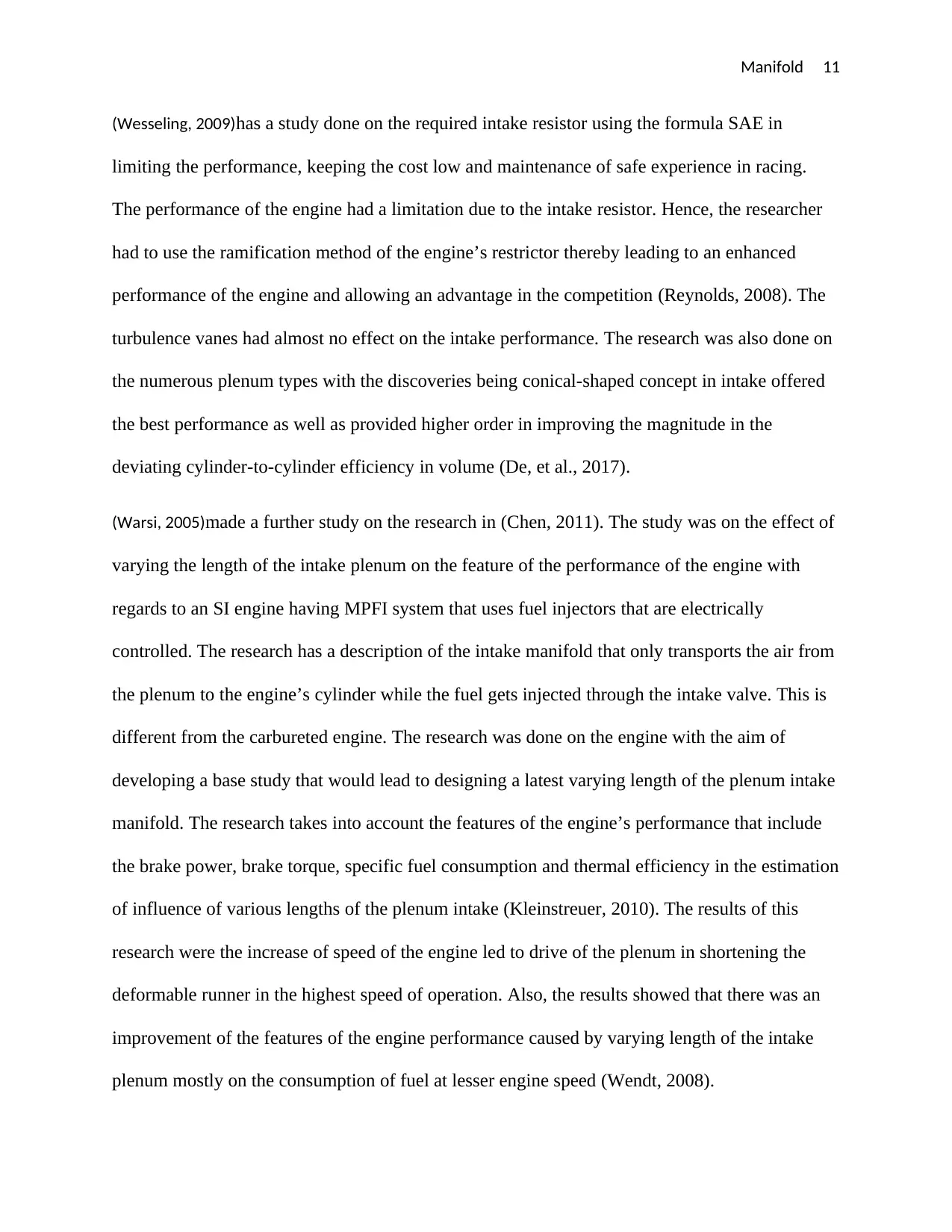
Manifold 11
(Wesseling, 2009)has a study done on the required intake resistor using the formula SAE in
limiting the performance, keeping the cost low and maintenance of safe experience in racing.
The performance of the engine had a limitation due to the intake resistor. Hence, the researcher
had to use the ramification method of the engine’s restrictor thereby leading to an enhanced
performance of the engine and allowing an advantage in the competition (Reynolds, 2008). The
turbulence vanes had almost no effect on the intake performance. The research was also done on
the numerous plenum types with the discoveries being conical-shaped concept in intake offered
the best performance as well as provided higher order in improving the magnitude in the
deviating cylinder-to-cylinder efficiency in volume (De, et al., 2017).
(Warsi, 2005)made a further study on the research in (Chen, 2011). The study was on the effect of
varying the length of the intake plenum on the feature of the performance of the engine with
regards to an SI engine having MPFI system that uses fuel injectors that are electrically
controlled. The research has a description of the intake manifold that only transports the air from
the plenum to the engine’s cylinder while the fuel gets injected through the intake valve. This is
different from the carbureted engine. The research was done on the engine with the aim of
developing a base study that would lead to designing a latest varying length of the plenum intake
manifold. The research takes into account the features of the engine’s performance that include
the brake power, brake torque, specific fuel consumption and thermal efficiency in the estimation
of influence of various lengths of the plenum intake (Kleinstreuer, 2010). The results of this
research were the increase of speed of the engine led to drive of the plenum in shortening the
deformable runner in the highest speed of operation. Also, the results showed that there was an
improvement of the features of the engine performance caused by varying length of the intake
plenum mostly on the consumption of fuel at lesser engine speed (Wendt, 2008).
(Wesseling, 2009)has a study done on the required intake resistor using the formula SAE in
limiting the performance, keeping the cost low and maintenance of safe experience in racing.
The performance of the engine had a limitation due to the intake resistor. Hence, the researcher
had to use the ramification method of the engine’s restrictor thereby leading to an enhanced
performance of the engine and allowing an advantage in the competition (Reynolds, 2008). The
turbulence vanes had almost no effect on the intake performance. The research was also done on
the numerous plenum types with the discoveries being conical-shaped concept in intake offered
the best performance as well as provided higher order in improving the magnitude in the
deviating cylinder-to-cylinder efficiency in volume (De, et al., 2017).
(Warsi, 2005)made a further study on the research in (Chen, 2011). The study was on the effect of
varying the length of the intake plenum on the feature of the performance of the engine with
regards to an SI engine having MPFI system that uses fuel injectors that are electrically
controlled. The research has a description of the intake manifold that only transports the air from
the plenum to the engine’s cylinder while the fuel gets injected through the intake valve. This is
different from the carbureted engine. The research was done on the engine with the aim of
developing a base study that would lead to designing a latest varying length of the plenum intake
manifold. The research takes into account the features of the engine’s performance that include
the brake power, brake torque, specific fuel consumption and thermal efficiency in the estimation
of influence of various lengths of the plenum intake (Kleinstreuer, 2010). The results of this
research were the increase of speed of the engine led to drive of the plenum in shortening the
deformable runner in the highest speed of operation. Also, the results showed that there was an
improvement of the features of the engine performance caused by varying length of the intake
plenum mostly on the consumption of fuel at lesser engine speed (Wendt, 2008).
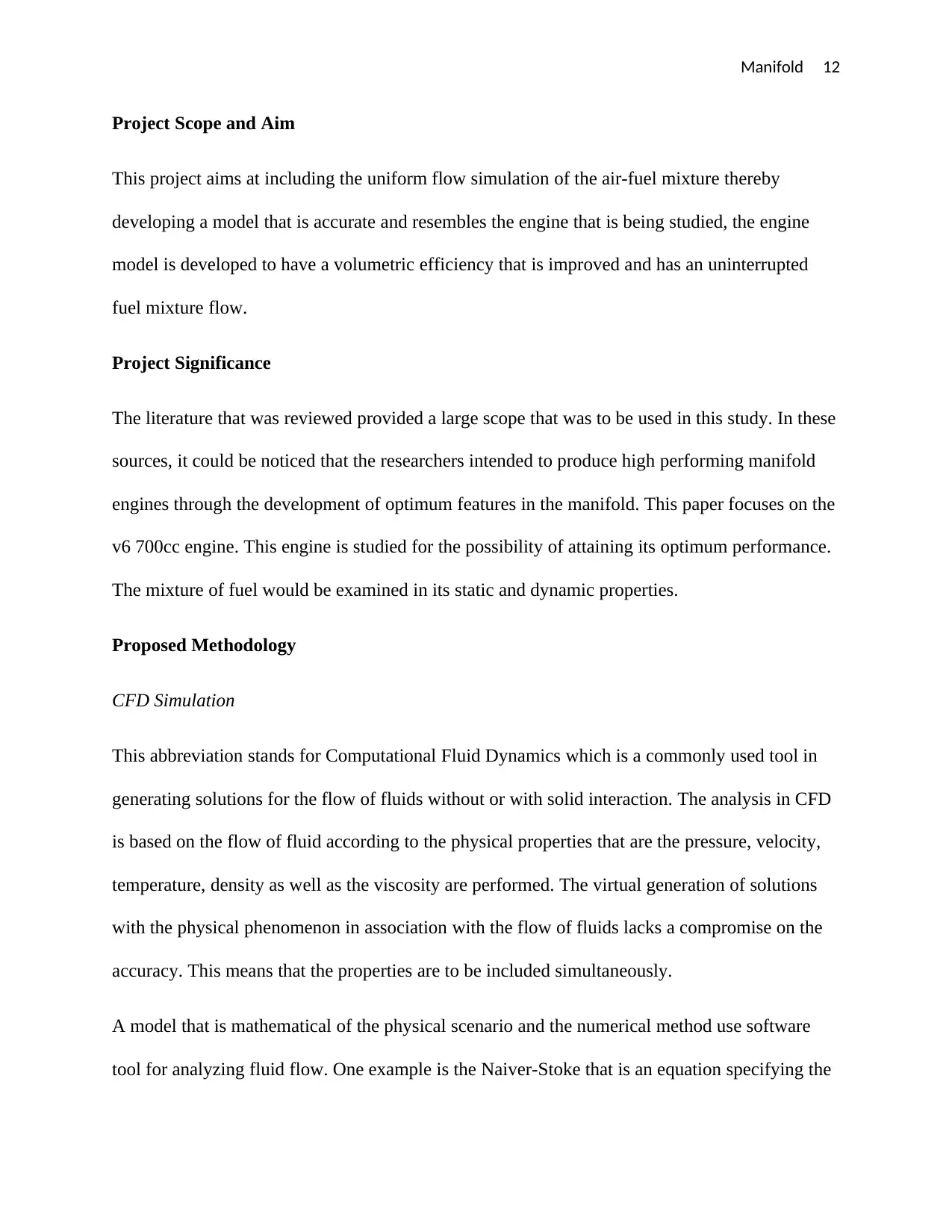
Manifold 12
Project Scope and Aim
This project aims at including the uniform flow simulation of the air-fuel mixture thereby
developing a model that is accurate and resembles the engine that is being studied, the engine
model is developed to have a volumetric efficiency that is improved and has an uninterrupted
fuel mixture flow.
Project Significance
The literature that was reviewed provided a large scope that was to be used in this study. In these
sources, it could be noticed that the researchers intended to produce high performing manifold
engines through the development of optimum features in the manifold. This paper focuses on the
v6 700cc engine. This engine is studied for the possibility of attaining its optimum performance.
The mixture of fuel would be examined in its static and dynamic properties.
Proposed Methodology
CFD Simulation
This abbreviation stands for Computational Fluid Dynamics which is a commonly used tool in
generating solutions for the flow of fluids without or with solid interaction. The analysis in CFD
is based on the flow of fluid according to the physical properties that are the pressure, velocity,
temperature, density as well as the viscosity are performed. The virtual generation of solutions
with the physical phenomenon in association with the flow of fluids lacks a compromise on the
accuracy. This means that the properties are to be included simultaneously.
A model that is mathematical of the physical scenario and the numerical method use software
tool for analyzing fluid flow. One example is the Naiver-Stoke that is an equation specifying the
Project Scope and Aim
This project aims at including the uniform flow simulation of the air-fuel mixture thereby
developing a model that is accurate and resembles the engine that is being studied, the engine
model is developed to have a volumetric efficiency that is improved and has an uninterrupted
fuel mixture flow.
Project Significance
The literature that was reviewed provided a large scope that was to be used in this study. In these
sources, it could be noticed that the researchers intended to produce high performing manifold
engines through the development of optimum features in the manifold. This paper focuses on the
v6 700cc engine. This engine is studied for the possibility of attaining its optimum performance.
The mixture of fuel would be examined in its static and dynamic properties.
Proposed Methodology
CFD Simulation
This abbreviation stands for Computational Fluid Dynamics which is a commonly used tool in
generating solutions for the flow of fluids without or with solid interaction. The analysis in CFD
is based on the flow of fluid according to the physical properties that are the pressure, velocity,
temperature, density as well as the viscosity are performed. The virtual generation of solutions
with the physical phenomenon in association with the flow of fluids lacks a compromise on the
accuracy. This means that the properties are to be included simultaneously.
A model that is mathematical of the physical scenario and the numerical method use software
tool for analyzing fluid flow. One example is the Naiver-Stoke that is an equation specifying the
⊘ This is a preview!⊘
Do you want full access?
Subscribe today to unlock all pages.

Trusted by 1+ million students worldwide
1 out of 23
Related Documents
Your All-in-One AI-Powered Toolkit for Academic Success.
+13062052269
info@desklib.com
Available 24*7 on WhatsApp / Email
![[object Object]](/_next/static/media/star-bottom.7253800d.svg)
Unlock your academic potential
Copyright © 2020–2025 A2Z Services. All Rights Reserved. Developed and managed by ZUCOL.



